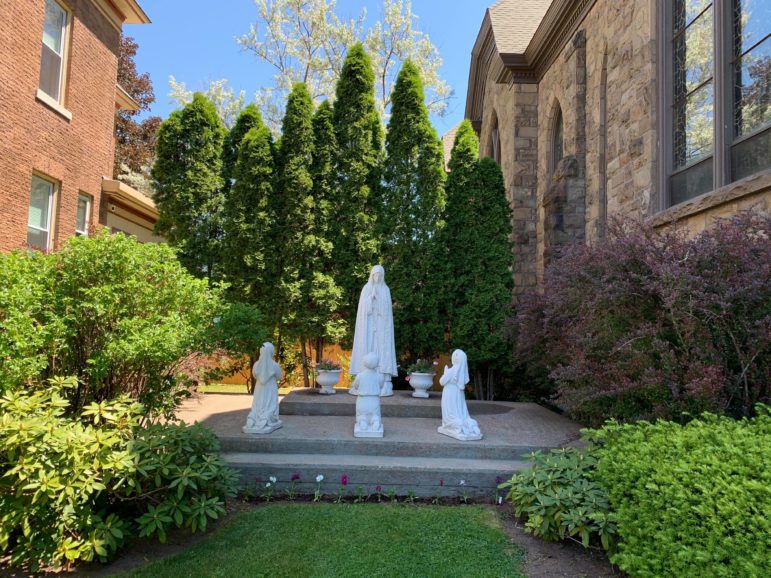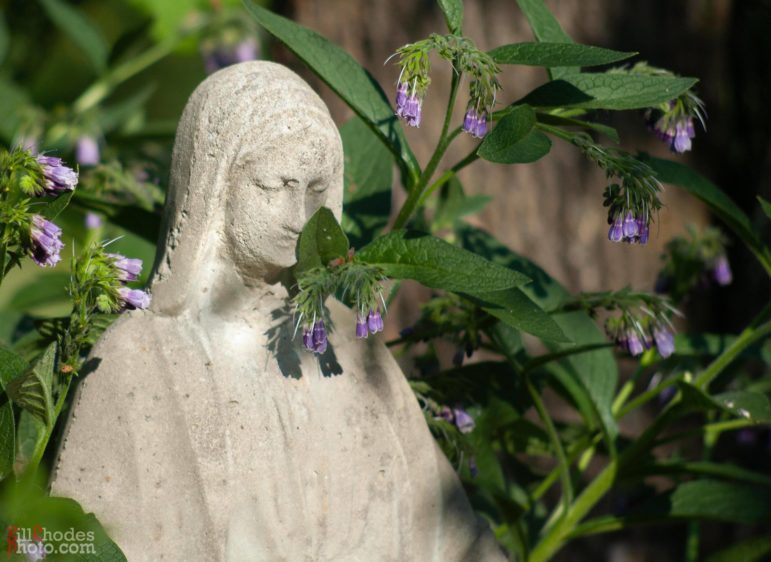
Some dear friends of mine recently packed up their household belongings and headed out for a new life on the West Coast. They said they have had enough of the racism, classism, and all the other “-isms” that sometimes make it difficult to live in the southeastern region of the United States, and they have high hopes about finding a more enlightened population in a more enlightened land. While I do not know that it is possible to geographically escape the “-isms,” I certainly admire their courage and willingness to try.
Shortly before they left, they sent a message asking if I would like to have some garden statuary that they were not going to take with them. The pieces on offer were a small pagoda and a statue of the Virgin Mary. I immediately and enthusiastically replied, “Yes!” There is usually room in my garden for beloved objects, and a few days later when the statues were delivered, I was happy to welcome them to a new home.

A statue in the churchyard of St. Patrick’s Church, Oneida, NY [courtesy Chris Rossi]
The pagoda was easy to place, tucked in between the garden bench and the Autumn Joy sedum. One of the only plants to have made the move from my old home to the gardens here at the cottage, this sedum represents stability and balance. The pagoda is, by design, a complement to those concepts.
Mary, on the other hand – well, I was not quite sure what to do with Mary.
At one point I wondered if I had made a mistake by accepting her. She spent some time hanging out in the stone wall garden where my friend placed her when he brought her over. Statuary Mary is no lightweight, and that was the closest flat place he could set her down. Then she moved to the gravel path between the stone wall garden and the garden proper. I think I subconsciously hoped that setting her feet on an actual path would prompt the land spirits or Mary herself to be a little more forthcoming where she needed to be. I have always considered her to be a gentle and patient figure, and I am grateful that she stayed true to her nature in these circumstances.
In the time Mary spent on that path, two different people asked me what I was doing with a statue of the Virgin Mary – that is, what was a Witch and a Pagan doing with a statue of the mother of the Christian god? I responded with my standard polite and non-committal answer to such questions, which is that Paganism holds space for all holy figures; we are generally not an exclusionary people. But I was not satisfied with that answer for myself.
I have loved Mary ever since childhood. She was my favorite figurine in the small nativity scene my mother set up on top of our console television every Christmas. I loved her blue robe and her sweet face. Sometimes I would take her out of the nativity and hold her cupped in my hands so I could whisper to her. Even as a child with no spiritual education, it was easier for me to connect with her feminine energy than to the male energy that dominates the Christian world.
When I was old enough to have wandering privileges and brave enough to overcome my fear of nuns, I walked from one block to the next through the side yard of the neighborhood Catholic church. On that adventure, I discovered a nearly life-sized statue of Mary on the church grounds. The statue was beautiful, and the spot was peaceful. By some twist of the mystic, there, in the presence of Mary, I found myself on holy ground for the first time.
The knowledge that there was a place where I could go to be with her was powerful. As a child, I felt the need to hold that knowledge and that place a secret, and I kept that secret until recently. Mary was never a constant presence in my life, but when I needed to connect with something beyond the human feminine, I knew I could go to her in a way that was close and personal. I visited her off and on until I moved away from my hometown when I was 14.
My spiritual journey through childhood and young adulthood took me through several iterations of Christian churches, though Catholicism was never one of them. I listened to countless sermons from both male and female clergy, sat through what seemed like eons of bible study lessons, yet I could never understand why Mary was portrayed as a woman who had a passive supporting role in a great mystery, when even a child could feel that she was so much more than that.

A close-up of the statue of Mary in the author’s garden [courtesy B. Rhodes]
When I embraced being a Witch and began to explore relationships with other divine and sacred beings, for the most part I put Mary away, along with the rest of the figures of Christianity. Though I have somewhat loosely related her to Brigid and several other goddesses in my personal practice, I have never engaged in research about her. In my early years of self-study, when I encountered information about Mary while searching for other things, I skipped over it. I simply did not have enough knowledge to clearly formulate the right questions to pursue study of her. But now these questions about why Mary was in this garden have prompted a search for both the questions and the answers.
I will be the first to acknowledge that a month’s worth of reading, research, and meditation does not qualify me as an expert on Mary, so I will leave the discussions about Mary and Isis, Brigid, Diana, Hera, Artemis, Demeter, and all the others to the academics and scholars.
However, my recent studies have deepened my personal understanding of who she was in her many incarnations. It has also deepened my understanding of my connection to her and how that has evolved.
“The essence of idolatry,” writes Alfred Gell in his book Art and Agency, An Anthropological Theory, “is that it permits real physical interactions to take place between persons and divinities.” What Pagan or Witch does not understand this from the very beginning of their practice, if not before then? I understood this, even if I could not have articulated it, when I was a 6-year-old child whispering to a tiny statue of Baby Jesus’s mother.
If someone had asked my younger self why I talked to the statue of Mary, I might have said that, because I could see her and touch her, she made the Christian god seem less scary. She made it easier to believe in things that did not quite seem real.
“The tangibility of the sacred through devotional objects demystified the connection to the divine making the unintelligible intelligible.” I found these words in an essay by Meg Baker, a student at Columbia University, called “Isis and the Virgin Mary: A Pagan Conversion.“ Reading those words while researching Mary was a light-bulb moment for me. Blue-robed Mary and the rest of the figures in my mother’s cherished nativity set were my first exposure to the divine being represented in a devotional object. My relationship with the statue at the church was an extension of my connection to that small nativity statue.
As a child, I had instinctively turned to Mary while seeking the comfort and healing of a mother’s love and grace, and all the times I have encountered her while journeying as a Witch I have done so while working with the healing aspects of another divine. Thus it was no surprise when my recent studies showed that she has been considered a healer across many systems of belief.
The southeast corner of my garden contains a healing garden filled with elderberry, comfrey, and beebalm. One morning I was sitting in an unusual spot, staring at Mary’s back while she stood on the gravel path. I was still trying to decide where to place her. A mourning dove called from the branches of a tree just beyond the healing garden and I raised my eyes to look for it. At that moment I saw what Mary had been facing the whole time her feet were on the path: the half-way point where the healing garden curves. I realized this was the place where she could infuse the healing plants with her healing energy, where she could stand, hands spread in blessing, as she overlooked the rest of the gardens and the cottage.
Between my research and Mary’s gentle guidance, I found the answer to the question. What is a Witch doing with a statue of Mary in her garden?
I am celebrating another extension of my connection to that tiny nativity Mary. I am holding gratitude for the presence of another healer. Every time I look at her where she stands in the healing garden, surrounded by the green leaves and purple-belled flowers of comfrey plants, I am reminded how easy it is to touch the power of the divine.
THE WILD HUNT ALWAYS WELCOMES GUEST SUBMISSIONS. PLEASE SEND PITCHES TO ERIC@WILDHUNT.ORG.
THE VIEWS AND OPINIONS EXPRESSED BY OUR DIVERSE PANEL OF COLUMNISTS AND GUEST WRITERS REPRESENT THE MANY DIVERGING PERSPECTIVES HELD WITHIN THE GLOBAL PAGAN, HEATHEN AND POLYTHEIST COMMUNITIES, BUT DO NOT NECESSARILY REFLECT THE VIEWS OF THE WILD HUNT INC. OR ITS MANAGEMENT.
The Wild Hunt is not responsible for links to external content.
To join a conversation on this post:
Visit our The Wild Hunt subreddit! Point your favorite browser to https://www.reddit.com/r/The_Wild_Hunt_News/, then click “JOIN”. Make sure to click the bell, too, to be notified of new articles posted to our subreddit.